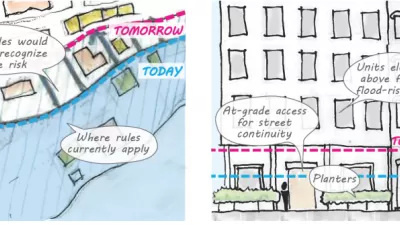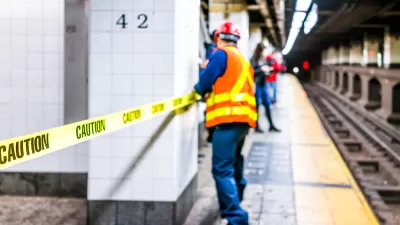Cassim Shepard and Varick Shute respond to an exhortation by Governor Cuomo to "build [the New York City area] back smarter" in the aftermath of Superstorm Sandy, and in the face of changing weather patterns, with some ideas on what that will entail.
There isn't one single solution to building a New York metropolitan area more able to withstand the "new reality" of rising seas and extreme weather incidents that threaten the city, argue Shepard and Shute, but rather a range of tactics across multiple scales that can make the area more responsive and resilient.
"The kind of coordination we have seen between federal, state, and local officials over the past few days points both to pathways and to pitfalls on the road towards multi-scalar collaboration. Financial, political, and practical collaboration will be vital to creating an infrastructure commensurate with the challenges ahead. The investments necessary won't come top-down from the federal government in our current political climate. Nor can we rely exclusively on the DIY, bottom-up efforts of community groups and individual citizens to build the infrastructure of the future."
"Both national leadership and community stewardship will be necessary, mediated by the policies, investments, and interventions of states and cities. To 'build it back smarter,' as Governor Cuomo has called for, will require a shift in understanding what infrastructure means, how it performs, and how – when it's well designed, resilient, and responsive – its public benefits extend outwards across multiple and nested scales of citizenship, from community, to state, to nation, to planet."
FULL STORY: From the Editors: Build It Back Smarter

Planetizen Federal Action Tracker
A weekly monitor of how Trump’s orders and actions are impacting planners and planning in America.

Maui's Vacation Rental Debate Turns Ugly
Verbal attacks, misinformation campaigns and fistfights plague a high-stakes debate to convert thousands of vacation rentals into long-term housing.

San Francisco Suspends Traffic Calming Amidst Record Deaths
Citing “a challenging fiscal landscape,” the city will cease the program on the heels of 42 traffic deaths, including 24 pedestrians.

Defunct Pittsburgh Power Plant to Become Residential Tower
A decommissioned steam heat plant will be redeveloped into almost 100 affordable housing units.

Trump Prompts Restructuring of Transportation Research Board in “Unprecedented Overreach”
The TRB has eliminated more than half of its committees including those focused on climate, equity, and cities.

Amtrak Rolls Out New Orleans to Alabama “Mardi Gras” Train
The new service will operate morning and evening departures between Mobile and New Orleans.
Urban Design for Planners 1: Software Tools
This six-course series explores essential urban design concepts using open source software and equips planners with the tools they need to participate fully in the urban design process.
Planning for Universal Design
Learn the tools for implementing Universal Design in planning regulations.
Heyer Gruel & Associates PA
JM Goldson LLC
Custer County Colorado
City of Camden Redevelopment Agency
City of Astoria
Transportation Research & Education Center (TREC) at Portland State University
Jefferson Parish Government
Camden Redevelopment Agency
City of Claremont





























